Active-TV Ecosystem Developers,
The Issue: The path to bringing Internet-delivered video to the TV has been a long one, with lots of disappointments and delays.
Solutions: The barriers to adoption until now include overly-ambitions business models, inappropriate use of complex technology, high-priced solutions and poor communication with end-users. These have all contributed to delays in bringing Internet video to the TV. It is now possible, however, using active-TV technology, to demonstrate simple and practical, as well as reliable, solutions that overcome these barriers. These solutions are on sale today in many consumer electronics retail stores (see http://www.dlink.com/activeTV/ ).
Behind the scene: The ease with which it is now possible to construct TV-web sites, supported by active-TV technology, will quickly lead to a flood of TV-web channels for living room TVs.
Starting with the premise that YouTube members can select their own video favorites, create or use existing playlists, and even arrange videos into a “channel”, individuals as well as companies such as National Geographic, BBC, Sony and many others, actively use YouTube as a means of further distributing their video portfolio – they upload with great frequency a veritable treasure-trove of interesting video clips. For example, at last count the National Geographic YouTube ‘channel’ included 252 videos, and the CBS channel had 3711 videos.
YouTube provides an interface for requesting these videos over the Internet. They actually provide the cut-and-paste code enabling the video to be embedded into a blog or website. I have taken a different approach and effectively pasted them into a TV-web channel. The simple steps and tools for accomplishing this where recently described in a blog article.
To demonstrate how easy it is to build TV-web channels, I have quickly created the 9 examples below. I will supply the support code at the http://active-tv.blogspot.com/ for anyone who wishes to add these channels to their active-TV technology-enabled TV or Set-Top Box. Additionally, D-Link is now supporting a free website for DSM-520 owners who want to add active-TV technology.
National Geographic TV-web image (based on National Geographic ‘channel’ on YouTube)

This BBC Top Gear channel looks interesting, but is not a success. Interestingly, anyone uploading video to YouTube can ‘mark’ the video, so limiting viewing options; in this case much of the video is marked “not to be embedded”. This means the video can only be views from the YouTube PC-web page. This is rarely a problem, but many of the very popular BBC Top Gear videos are ‘marked’ as such and cannot be viewed outside the YouTube PC-web page.

Warner Brothers music video TV-web image (based on Warner Brothers ‘channel’ on YouTube)

David Pogue is a New York Times technology columnist. He does not have a YouTube channel. But it is still possible to group relevant videos into a TV-web channel. Without the use of YouTube channel grouping, there is always a small chance that the video selection filter used to gather video clips may allow an inappropriate or unrelated video to be included in the ‘Pogue’ TV-web channel line-up.

Sony Pictures UK TV-web image (based on Sony’s ‘channel’ on YouTube)

CBS

Intel

Rudy Giuliani

Hillary Clinton

There was a bug in the TV-web Flash support code released previously at http://active-tv.blogspot.com/ . The bug was introduced by a software protection tool. It is now fixed and the blogspot download software has been updated. I was not able to devote the time to clearing this problem up sooner. The bug caused a problem with left-right swapping used to protect Plasma TVs. All should be resolved now.
So far I have made examples in 4x3 TV format, but will start adding widescreen or 16x9 format, as there have been several requests for this.
Feedback, corrections and comments welcome. Contact me for more information or support with active-TV technology development.
Daniel Mann
The Issue: The path to bringing Internet-delivered video to the TV has been a long one, with lots of disappointments and delays.
Solutions: The barriers to adoption until now include overly-ambitions business models, inappropriate use of complex technology, high-priced solutions and poor communication with end-users. These have all contributed to delays in bringing Internet video to the TV. It is now possible, however, using active-TV technology, to demonstrate simple and practical, as well as reliable, solutions that overcome these barriers. These solutions are on sale today in many consumer electronics retail stores (see http://www.dlink.com/activeTV/ ).
Behind the scene: The ease with which it is now possible to construct TV-web sites, supported by active-TV technology, will quickly lead to a flood of TV-web channels for living room TVs.
Starting with the premise that YouTube members can select their own video favorites, create or use existing playlists, and even arrange videos into a “channel”, individuals as well as companies such as National Geographic, BBC, Sony and many others, actively use YouTube as a means of further distributing their video portfolio – they upload with great frequency a veritable treasure-trove of interesting video clips. For example, at last count the National Geographic YouTube ‘channel’ included 252 videos, and the CBS channel had 3711 videos.
YouTube provides an interface for requesting these videos over the Internet. They actually provide the cut-and-paste code enabling the video to be embedded into a blog or website. I have taken a different approach and effectively pasted them into a TV-web channel. The simple steps and tools for accomplishing this where recently described in a blog article.
To demonstrate how easy it is to build TV-web channels, I have quickly created the 9 examples below. I will supply the support code at the http://active-tv.blogspot.com/ for anyone who wishes to add these channels to their active-TV technology-enabled TV or Set-Top Box. Additionally, D-Link is now supporting a free website for DSM-520 owners who want to add active-TV technology.
National Geographic TV-web image (based on National Geographic ‘channel’ on YouTube)

This BBC Top Gear channel looks interesting, but is not a success. Interestingly, anyone uploading video to YouTube can ‘mark’ the video, so limiting viewing options; in this case much of the video is marked “not to be embedded”. This means the video can only be views from the YouTube PC-web page. This is rarely a problem, but many of the very popular BBC Top Gear videos are ‘marked’ as such and cannot be viewed outside the YouTube PC-web page.

Warner Brothers music video TV-web image (based on Warner Brothers ‘channel’ on YouTube)

David Pogue is a New York Times technology columnist. He does not have a YouTube channel. But it is still possible to group relevant videos into a TV-web channel. Without the use of YouTube channel grouping, there is always a small chance that the video selection filter used to gather video clips may allow an inappropriate or unrelated video to be included in the ‘Pogue’ TV-web channel line-up.

Sony Pictures UK TV-web image (based on Sony’s ‘channel’ on YouTube)

CBS

Intel

Rudy Giuliani

Hillary Clinton

There was a bug in the TV-web Flash support code released previously at http://active-tv.blogspot.com/ . The bug was introduced by a software protection tool. It is now fixed and the blogspot download software has been updated. I was not able to devote the time to clearing this problem up sooner. The bug caused a problem with left-right swapping used to protect Plasma TVs. All should be resolved now.
So far I have made examples in 4x3 TV format, but will start adding widescreen or 16x9 format, as there have been several requests for this.
Feedback, corrections and comments welcome. Contact me for more information or support with active-TV technology development.
Daniel Mann





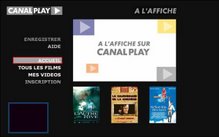
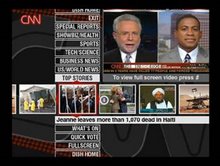
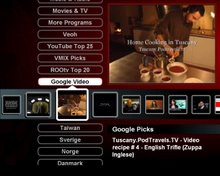
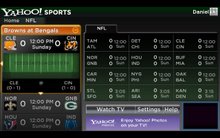

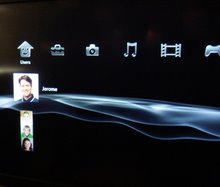
1 comment:
I love the you-tube channels , I can watch a lot of information, I think that many thinks such as the Behind the scene and The Issue are so important, I like the images!22dd
Post a Comment